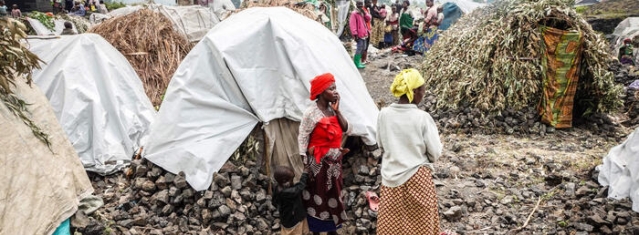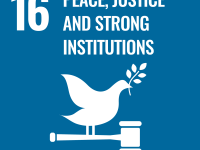News
DR CONGO: THE HUMANITARIAN CRISIS IN NORTH KIVU IS ESCALATING
ReliefWeb Press Release

Displaced persons in North Kivu DR Congo (Source: © Kaya Boyongo/ICRC)
ARAC International Strategic Communications -
The armed conflict in North Kivu province between the March 23 Movement (M23) and the Congolese army (FARDC) has intensified, with devastating consequences for civilians. The fighting, which had previously been confined to Rutshuru territory, has spread to Masisi territory, causing hundreds of thousands of people to flee for the provincial capital of Goma.
"The conflict is nearing densely populated urban areas, which is extremely concerning," says Pascal Hundt, head of the International Committee of the Red Cross (ICRC) delegation in the Democratic Republic of the Congo. "The ICRC reminds all parties to the conflict that they must respect international humanitarian law, including by taking every feasible precaution to protect civilians and civilian objects from combat."
"The conflict is nearing densely populated urban areas, which is extremely concerning," says Pascal Hundt, head of the International Committee of the Red Cross (ICRC) delegation in the Democratic Republic of the Congo. "The ICRC reminds all parties to the conflict that they must respect international humanitarian law, including by taking every feasible precaution to protect civilians and civilian objects from combat."
Clashes between M23 combatants and the FARDC have erupted again on a large scale, forcing hundreds of thousands of civilians to flee.
"This crisis is on the way to becoming a humanitarian catastrophe," says Anne-Sylvie Linder, head of the ICRC subdelegation in Goma. "If the displacement continues, it will outstrip our capacity to respond, and that of the other humanitarian organizations. There may not be space to take all of the people. Already there is no room left in Nyiragongo territory, which took in the first arrivals."
"When the fighting ramped up, people panicked and ran in every direction," says Béatrice Ndayunvayino, 35, a resident of Kingi, Masisi territory. "I fled with my six children, a pot and a jerrycan to the school in Sake, where there were already so many people."
"This crisis is on the way to becoming a humanitarian catastrophe," says Anne-Sylvie Linder, head of the ICRC subdelegation in Goma. "If the displacement continues, it will outstrip our capacity to respond, and that of the other humanitarian organizations. There may not be space to take all of the people. Already there is no room left in Nyiragongo territory, which took in the first arrivals."
"When the fighting ramped up, people panicked and ran in every direction," says Béatrice Ndayunvayino, 35, a resident of Kingi, Masisi territory. "I fled with my six children, a pot and a jerrycan to the school in Sake, where there were already so many people."
Repeated displacements
Some people have had to pick up and leave multiple times owing to the incessant fighting, including thousands who have ended up in Goma. Others move back and forth, constantly adapting to security conditions that can quickly deteriorate.Mother of six Rachel Masika, 30, says, "I took the road to Tongo, and then I made it to Kabizo, where I only stayed for a few days. Then I went to Katsiru. After that, I went to Kitchanga. But after a week, people started fleeing the city, so I walked to Sake. It took me three and a half weeks in all. It's exhausting."
These repeated displacements, along with the worsening security conditions, make it even more difficult to get humanitarian aid to the conflict's many victims.
Increasingly precarious living conditions
Aside from the makeshift camps where people fleeing the fighting have squeezed together, a number of people from the area, who themselves live in insecure circumstances, have taken new arrivals into their homes.The living conditions are precarious for those who have been displaced. Cécile Nabuko, who left her home for Sake, says, "We sleep like animals crammed together. But what can we do? When you've been displaced, you don't have time to sleep. You make do with wherever you can rest your head because you're not at home."
Humanitarians estimate that there are now more than 300,000 displaced people in Goma. Anne-Sylvie Linder says, “Some of them are at Bulengo or Lac Vert – where a site was prepared – as well as Rusayo, an outlying district in Goma where authorities have made several acres available. The Lac Vert site nevertheless poses a significant risk to the people there because of the potential for the release of dangerous methane gas.”
The more or less daily arrival of newly displaced people to Goma and the surrounding area is taxing essential social services and making it more difficult for those in the area, whether residents or displaced people, to access what they need to survive. That includes food and water but also access to health-care facilities where the sick and injured are streaming in.
What the ICRC is doing
The ICRC has taken a number of steps to help people affected by the conflict, especially in and around Rutshuru, Nyiragongo and southern Lubero territories.The organization has supported the care of the injured in the Bethesda-Ndosho hospital centre in Goma, at the general hospital in Beni and in the provincial hospital in Bukavu, where it runs a war-surgery programme. “We are constantly running near full capacity at the Ndosho hospital centre,” says Anne-Sylvie Linder. “I think we’re looking at a large-scale humanitarian crisis whose fallout will be felt for the medium to long term.”
The ICRC works in close collaboration with the Red Cross Society of the Democratic Republic of the Congo around providing first aid, improving access to water and sanitation, and restoring family links.
For additional information, please contact:
Alyona Synenko, ICRC Nairobi, Tel: +254 716 897 265, asynenko@icrc.orgCarol Lumingu Kazadi, ICRC Kinshasa, Tel. : +243 (0) 81 292 59 14, clumingukazadi@icrc.org
=====================================================
ARAC International, Strategic Communications & Analysis
Global Security Analyst | Human Rights Consultant
In partnership with the U.S. Agency for International Development (USAID)
U.S. Institute for Diplomacy and Human Rights Consultant
Institute for Economics and Peace Ambassador
Member of the International NGO Safety & Security Association (INSSA)
Member of UN OCHA Humanitarian Response
https:/iep.arac-international.org
more information: https://www.arac-international.org/2023/03/democratic-republic-of-congo.html
Liability for this article lies with the author, who also holds the copyright. Editorial content from USPA may be quoted on other websites as long as the quote comprises no more than 5% of the entire text, is marked as such and the source is named (via hyperlink).






